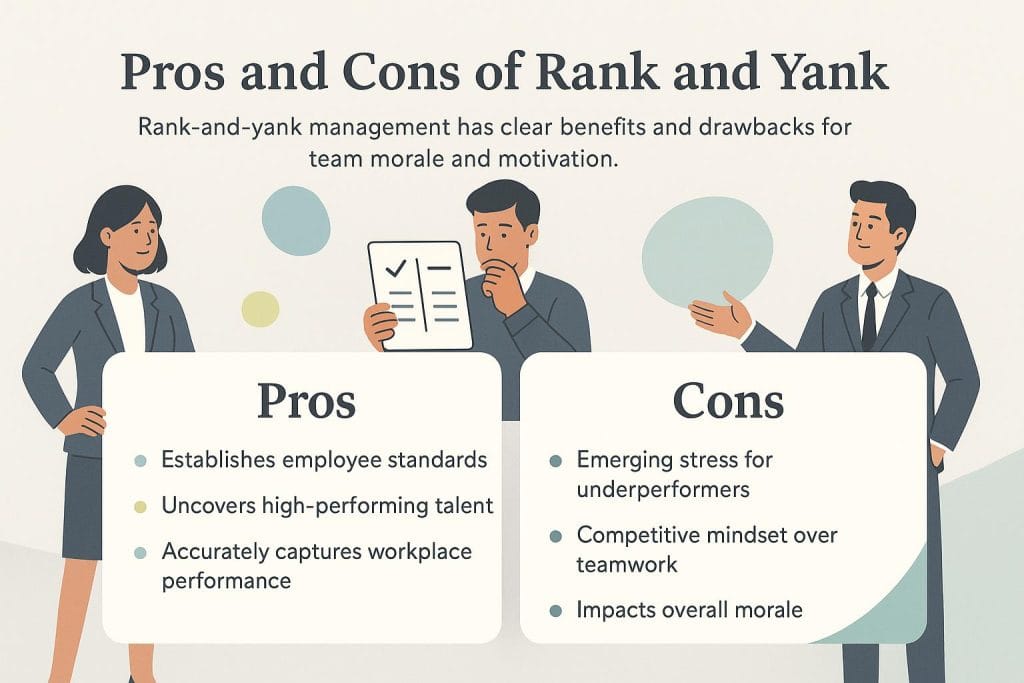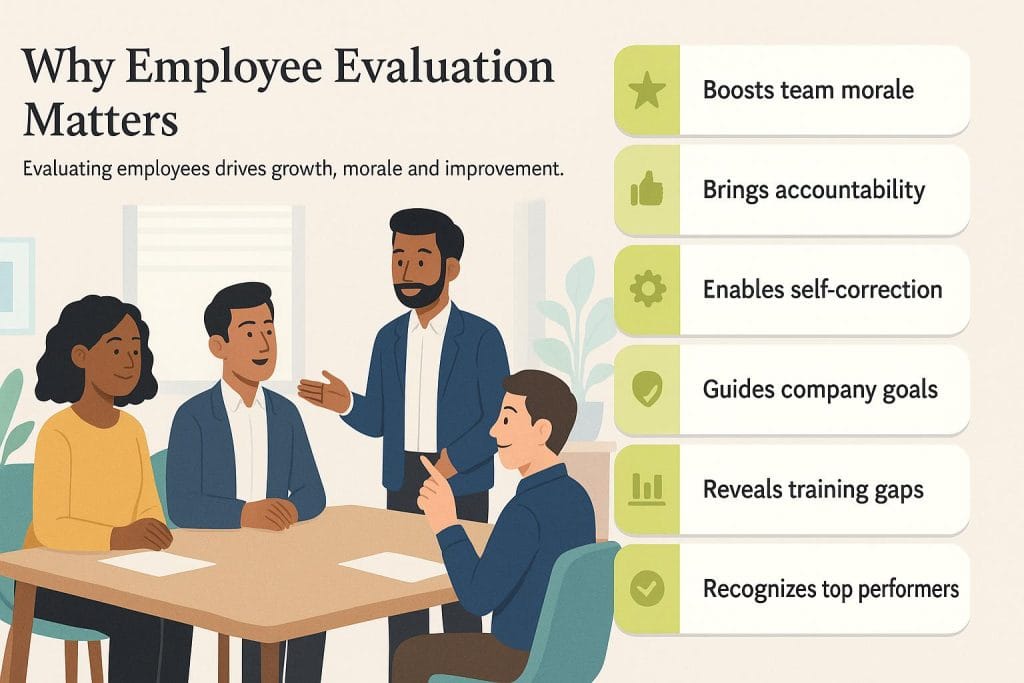Business.com aims to help business owners make informed decisions to support and grow their companies. We research and recommend products and services suitable for various business types, investing thousands of hours each year in this process.
As a business, we need to generate revenue to sustain our content. We have financial relationships with some companies we cover, earning commissions when readers purchase from our partners or share information about their needs. These relationships do not dictate our advice and recommendations. Our editorial team independently evaluates and recommends products and services based on their research and expertise. Learn more about our process and partners here.
The End of Rank and Yank: Management Practices Revisited
This management style has fallen out of favor — for good reason.

Table of Contents
As a business owner, it’s important to have employees who give their best effort and possess the necessary business skills and knowledge to help your company succeed. But how do you determine which employees are making a valuable contribution to your business and which ones aren’t pulling their weight?
There are many ways to assess employees, and every business must identify an appropriate methodology for its needs. As businesses continue exploring new management styles, looking back at older methodologies can help inform current management practices. We’ll examine a management style known as “rank and yank” to explore whether its tenets can help or harm organizations today.
What is rank and yank?

“Rank and yank” is a term used to describe an employee evaluation practice. When conducting a rank-and-yank assessment, companies rank and compare employees. The lowest-ranking employees are terminated.
Rank and yank is also known as “stack ranking,” “set distribution,” “forced ranking” and “vitality curve.” Simply put, it’s when you rank employees by performance and terminate employees at the bottom.
“While the term ‘rank-and-yank’ is rudimentary and comes off as a bit barbaric, the concept is really all about assessing talent pools and culling the bottom 10 to 20 percent,” explained Clark Lowe, president and CEO of the O’Connor Company. “In leadership, you start to learn that 80 percent of your time and energy goes into the bottom 20 percent of your organization. Likewise, oftentimes, 80 percent of your contributions (output and results) are from the top 80 percent of your company — often coined as the 80/20 rule.”
This assessment method was developed by the late Jack Welch when he was CEO of General Electric in the 1980s (though the legal profession practiced it well before that). Stack ranking requires managers to rate their subordinates in a hierarchical order from top to bottom. Those at the bottom aren’t necessarily poor performers; they’re just ranked that way because, well, somebody has to be.
Pros and cons of rank and yank

Like all management theories and styles, rank-and-yank practices have pros and cons.
Pros
- Rank and yank allows employers to establish a standard for all employees.
- Rank and yank can help you create incentives, such as employee bonuses for those who perform well.
- Rank and yank helps accurately report employee performance.
Cons
- Rank and yank demoralizes underperformers. Those who don’t perform quite as well as others (even if they still perform well) may worry about losing their positions.
- Rank and yank promotes looking out for oneself above team collaboration.
- Rank and yank’s spirit of workplace competition can undermine employee morale overall.
What rank-and-yank defenders say

Rank-and-yank defenders say this practice can help align employee performance with company objectives and business goals, but it’s widely misunderstood. They argue the term is often misapplied to a management approach that can actually benefit both workers and leadership.
“You have an active process that is sorting and aligning talent with company goals,” Lowe explained. “Many companies do not talk about talent enough. Talent conversations often only happen with need — someone quits or is terminated, and a need is created. [Rank and yank] is taking a more proactive approach and creating your own internal churn.”
Welch felt this management practice was unfairly villainized. “Most experienced businesspeople know that ‘rank and yank’ is a media-invented, politicized sledgehammer of a pejorative that perpetuates a myth about a powerfully effective real practice called (more appropriately) differentiation,” Welch wrote.
He explained that employee differentiation comes from a place of business transparency and honesty. “Unlike ‘rank and yank’ — I hate even using that term — differentiation isn’t about corporate plots, secrecy or purges,” Welch wrote. “It’s about building great teams and great companies through consistency, transparency and candor. It’s about aligning performance with the organization’s mission and values. It’s about making sure that all employees know where they stand.”
Welch insisted that differentiation, unlike its media portrayal, is a time-proven and successful technique. “Differentiation is nuanced, humane and occasionally complex, and it has been used successfully by companies for decades,” Welch noted. “Maybe that’s not as headline-worthy as you-know-what, but reality rarely is.”
Jorge Tittinger, the founder and president of Tittinger Consulting, noted that businesses may resort to rank-and-yank practices when pressed to increase productivity quickly or if they need a performance-driven justification for layoffs. “Managers find the model appealing if they can use a Darwinian-type productivity instrument — keep just the top performers and discard the weakest links,” Tittinger said. “In highly competitive cases, proponents believe it can drive short-term productivity improvements.”
What rank-and-yank detractors say
Rank-and-yank detractors say this management practice is outdated and ineffective for the following reasons.
Rank and yank is often mismanaged.
The idea behind employee rating systems is to identify and eliminate underperforming employees, making room for more innovative and motivated workers. However, managers who don’t understand how to be true leaders can easily abuse ranking systems for the following reasons:
- To make themselves look good (by trying to get the largest percentage of high rankings, regardless of actual merit)
- To get rid of someone they perceive as a threat to their position
- To punish insubordination
- To keep a star performer from job hopping by giving a good but not top-tier evaluation
“Rank-and-yank naturally encourages intra-team competition over cooperation, especially when team members realize that helping a colleague will hurt their ranking,” Tittinger cautioned. “It also fails to consider contextual elements like team dynamics, external pressures or learning curves.”
Rank and yank lets good employees slip through the cracks.
Rank and yank often forces managers to sacrifice good employees to protect those considered more essential. Employees who, for whatever reason, end up in the bottom rankings are fired under the assumption that the company must continually allow the cream to rise to the top. But while the cream may rise, too many otherwise good workers are left to sour.
“Some leaders cling to it because it fuels cuts but not the hard work, such as having real performance conversations, investing in growth or battling bias,” said Tara Furiani, CEO of Not the HR Lady. “But this model begets a self-protection, not innovation culture.”
Rank and yank contradicts today’s workplace focus.
Generally, the tenets of rank and yank contradict current workplace trends that promote work-life balance, remote work and employee collaboration. Today’s workplaces often feature on-site gyms, office pets, yoga classes and other creative perks designed to boost morale, improve employee retention and attract top candidates.
Rank and yank reflects outdated, fear-based leadership thinking.
Furiani cautioned that rank and yank is a relic of a discarded management approach that conflated leadership with fear. “Playing employees against each other and throwing out the bottom performers might sound gutsy on paper, but in practice, it’s cowardly leadership masquerading as corporate jargon,” Furiani said.
The problem is that this management practice assumes performance is unrelated to company culture, leadership or systems. “Businesses are not sports teams,” Furiani emphasized. “You don’t bench someone and put in new legs without reviewing the playbook, the coaching staff and whether the field is even level.”
Alternatives to rank and yank
Many employee measurement approaches can replace rank and yank and support more effective outcomes. Consider the following performance review models:
360-degree performance review model
One alternative approach is the 360-degree evaluation, where superiors, peers and subordinates rate employees. The idea is that everyone receives feedback to better understand their strengths and weaknesses.
“360-degree evaluations are time-consuming but very thorough,” Lowe explained. “Typically, these are best in middle and upper management positions where feedback is vital to growth. Rank-and-yank often happens in the bottom third of the hierarchy. 360-degree evaluations are not a parallel tool to rank-and-yank — they look at two different sides of the business.”
However, this approach has the following downsides:
- Personal prejudice: Feedback is sometimes based on personal biases rather than objective evaluation.
- Reluctance to criticize peers: Peers might be hesitant to say anything “bad” about each other, particularly in cases where 360-degree evaluations are not confidential and are shared among employees.
- Fear of reprisal: Criticizing a manager, even constructively, carries the risk of retaliation from subpar managers. In many organizations, ineffective managers have more power to affect their subordinates than the other way around.
Calibration
Calibration is a performance review method that operates on a ranking system, but with checks and balances in place. Various managers who oversee comparable groups all review each other’s employee performance ratings. This way, the rankings and the reasons behind them are all discussed and debated to ensure no prejudices, biases or personal reasons influence a specific ranking.
“Calibration is equal to grading on the curve,” Lowe explained. “[However], calibration requires data and time, which can make the process slow and sluggish.”
Management by objective
Peter Drucker, a renowned management consultant, was the first to implement this management and review style. Essentially, the manager and employee sit down together to set employee performance goals and agree on how these goals will be achieved. The performance review is based solely on how the employee meets the set goals.
Since the goals and desired results are determined ahead of time by the employee and manager, the employee is fully aware of performance expectations. There are few excuses that can justify a failure to deliver on those expectations.
Peer review
This approach has some middle- and high-school energy to it. With a peer review, co-workers review and comment on an employee’s performance. This method might present more issues than the others listed above. Still, employees may receive more tailored reviews, insightful performance improvement plans and personal tips based on their strengths and weaknesses.
The importance of evaluating employees

Every organization must evaluate employee performance. Not every employee will be stellar; at some point, you may have to deal with unproductive workers, toxic employees, excessive employee absenteeism and workers who lack the proper skills to do the job. You may also need to address otherwise good team members who are in a slump or need guidance.
A consistent, respectful employee evaluation process is essential for the following reasons:
- Evaluating employees can boost team morale: When you address and take action to correct situations with ineffective or toxic employees, your team morale will improve. Your team will see that you’re in control of the workplace and that bad behavior won’t be ignored or rewarded.
- Evaluating employees brings accountability and development: When employees understand their job expectations and know they’re responsible for meeting them, they’re more likely to put in the necessary effort to do their best. “Employee assessment is crucial for individual and organizational development,” Tittinger noted. “When done properly, it gives clarity to expectations, acknowledges accomplishments and pinpoints areas for improvement.”
- Evaluating employees allows for self-correction: Evaluating employees, even with informal feedback, allows you to point out mistakes and behaviors a worker may be unaware of or that result from a temporary situation. Communicating your concerns and giving the employee time to improve fosters trust and mutual understanding. Additionally, salvaging an employee relationship means saving the money, time and downtime involved in recruiting, training and onboarding a new employee.
- Evaluating employees helps you modify company goals: If you conduct a department-wide employee evaluation and see that many employees have fallen short, it’s time to reevaluate your business goals. You may have set unrealistic targets, or changing market conditions may have rendered current goals impossible. Your evaluations will help you set attainable and realistic goals.
- Evaluating employees helps you identify training gaps: Let’s say an evaluation shows that new employees (or even existing employees) are struggling to understand company processes, policies or products. If this result is pervasive, it may indicate that you need to improve your employee training.
- Evaluating employees helps you share positive reinforcement and rewards: Employee evaluations aren’t just for weeding out and correcting underperformers; they also help identify and reward the best performers. Your entire team will be motivated when you offer rewards ranging from recognition to internal promotions. “It sends the message that the organization cares about each individual’s success,” Tittinger said. “When assessments are equitable, ongoing and feedback-intensive, they promote a culture of learning, accountability and trust.”
Amanda Hoffman contributed to this article.










